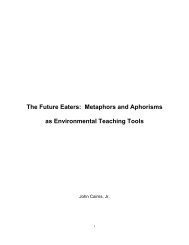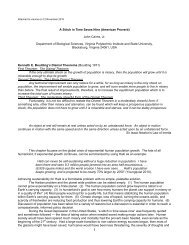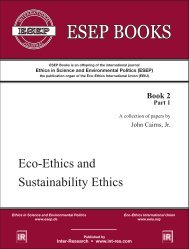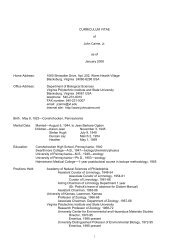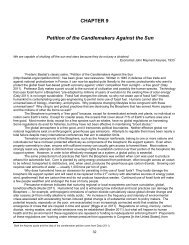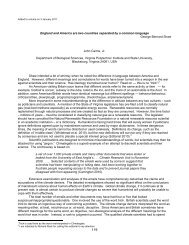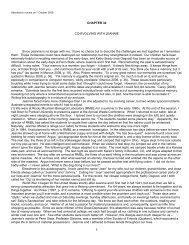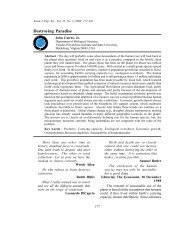View - ResearchGate
View - ResearchGate
View - ResearchGate
You also want an ePaper? Increase the reach of your titles
YUMPU automatically turns print PDFs into web optimized ePapers that Google loves.
188Cairns: Eco-Ethics and Sustainability Ethicsequality.’ The twenty-first century is likely to be a defining era for sustainability initiatives. If theyare delayed too long, degraded natural systems may not have the resilience to return to the ecologicalconditions favorable to humankind.The solution must begin with the recognition that Earth is finite and neither human population northe amount of Earth’s resources per capita can further increase substantially. The inescapable conclusionis that, to achieve both social and environmental justice, more equity and fairness must bepresent in Earth’s resources used per capita globally. The next ethical decision is whetherhumankind wishes an optimum quality of life (somewhat more resources per capita) or a meresurvival quality of life (barely adequate resources per capita). If quality of life is measured by suchcriteria as literacy, longevity, low infant mortality, and large social capital (i.e. benign social interactions)and small to modest material goods acquisition per capita, then each individual and nationstatewill have an ecological footprint size that is sustainable. In addition, natural capital and theecosystem services it provides will be protected and cherished. This protection is the sine qua nonof sustainable use of the planet.Fierce resistance will come from individuals with a large ecological footprint size and the fewindividuals and organizations who get a disproportionate share of Earth’s resources. Justice maybe achieved by stabilizing the population size of nation-states by enforcing zero net immigration(e.g. Cairns, in press) and limiting family size and resource allocation. The alternative is to let naturallaw determine both population size and resource allocation. This situation is even less attractivethan the one just described.ACKNOWLEDGEMENTSI am indebted to K Cairns for transferring the handwritten first draft to the word processor and to D Donaldfor editorial assistance.LITERATURE CITEDAgyeman J, Bullard RD, Evans B (2003) Joined-up thinking: bringing together sustainability, environmentaljustice and equity. In: Agyeman J, Bullard RD, Evans B (eds) Just sustainabilities. MIT Press, Cambridge,MA, pp 1–16Boulding K (1966) The economics of the coming spaceship Earth. In: Jarrett H (ed) Environmental quality ina growing economy. Harper and Row, New York, pp 3–15Cairns J Jr (In press) Sustainability ethics: zero net immigration. The Social ContractDobson A (2003) Social justice and environmental sustainability: ne’er the twain shall meet. In: Agyeman J,Bullard RD, Evans B (eds) Just sustainabilities. MIT Press, Cambridge, MA, pp 83–95Hardin G (1974) Living on a lifeboat. BioScience 24(10):561–568Myers N, Kent JV (1998) Perverse subsidies: tax $s undercutting our economies and environment alike. InternationalInstitute for Sustainable Development, Winnipeg, ManitobaRees WE, Westra L (2003) When consumption does violence: can there be sustainability and environmentaljustice in a resource-limited world? In: Agyeman J, Bullard RD, Evans B (eds) Just sustainabilities. MITPress, Cambridge, MA, pp 99–124Torras M, Boyce JK (1998) Income, equality and pollution: a reassessment of the environmental KuznetsCurve. Ecological Economics 25:147–160



